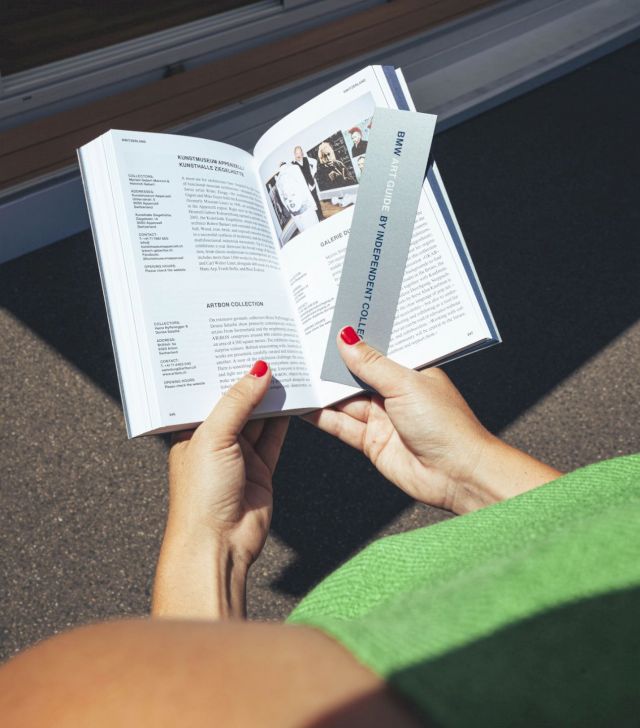The Door Opener
The 7th edition of the BMW Art Guide by INDEPENDENT COLLECTORS takes you to more than 304 collections in 51 countries and 224 cities.

The coleção moraes-barbosa (cmb), founded by Brazilian engineer and former bond trader Pedro Barbosa and executive Patrícia Moraes, has dedicated the last 20 years to more than gathering artworks but to reflecting the changes and fluctuations of the art world. The starting point in 1999 focused on Brazilian avant-garde of the 1950s, later inclining towards international and local contemporary artists, and most importantly, towards conceptual art in general, becoming the main interest of the collection, with an important role of the partnership with Italian author and curator Jacopo Crivelli Visconti in that development.
Since its founding, it has become clear that the collection alone could not capture the dimension of contemporary art, often in connection and collaboration with other art forms such as dance, performance, experimental music, visual and sound poetry, apart from the numerous other materials that the art circuit produces, such as announcement cards, posters, and publications. For this reason, the moraes-barbosa archive was formed 8 years ago, not only to house but also to encourage the creation of content and critical texts that better reflect the current situation of contemporary art as a dynamic, interrelated, and often unclassifiable field.
More recently, cmb has taken steps toward a larger contact with the public, artists, educational institutions, and researchers, tackling initiatives such as a grant program that has archive materials as a catalyst for poetic and critical productions. In November 2021, cmb inaugurated its own space in São Paulo, that is dedicated to hosting shows, talks, and screenings. Possession State: Notes For An Aesthetic Of Torture, the first event to take place, was curated by Cris Ambrosio and Deyson Gilbert, both of which have experience with working at the archive and with artistic practice.
Displaying only pieces of the collection with a non-venerative approach, creating compositions of overlapping documents of various rarity degrees, works of art, publications, and sometimes even everyday objects, the exhibition proposes an understanding of art and culture that surpasses the more generalised idea that art represents positive values and uses in society. Works like Tony Cokes’s 2011 Evil.16 (Torture.Musik) and the 1939 book Por qué hice las chekas de Barcelona. Laurencic ante el Consejo de Guerra [Why did you make the checas in Barcelona? Laurencic facing the war council] by R.L. Chacón, published in Franco’s Spain, tell stories about pop music and the modern avant-garde being instrumentalized in military contexts as tools of torture. That, along with Theodor W. Adorno and Max Horkheimer’s reading of Odysseus tied to his vessel’s mast to both prevent his killing and enjoy the siren’s chant, that loses its purpose and becomes art, were the gravitational axis of the show’s concept. The works also include stanley brouwn, Hito Steyerl, Cildo Meireles, Iman Issa, Iole de Freitas, Marcel Broodthaers, Antonio Dias, among others.
![Vito Acconci, Following Piece, 1969; Clara Ianni, Abstract work, 2010; Wlademir Dias-Pino, Poster for the 14th São Paulo Biennial, 1977; Antonio Dias, The idea of a body, 1972; Guaita, Stanislas de. Templo de Satã. São Paulo, Editora Três. 1973; Anver Bilate e Jorge Audi. in Revista Cruzeiro: Le Cocq vingado [Le Cocq avenged]. year XXXVII, number 3. 1964](/site/assets/files/25143/2023-06-14_13-44-51_possession-state-notes-for-an-aesthetic-of-torture_bmw_art_guide_by_independent_collectors.640x0.jpg)








![Guaita, Stanislas de. Templo de Satã. São Paulo, Editora Três. 1973; Anver Bilate e Jorge Audi. in Revista Cruzeiro: Le Cocq vingado [Le Cocq avenged]. year XXXVII, number 3. 1964](/site/assets/files/25143/2023-06-14_13-46-29_possession-state-notes-for-an-aesthetic-of-torture_bmw_art_guide_by_independent_collectors.640x0.jpg)




Photos: Ding Musa, courtesy of moraes-barbosa collection.
The 7th edition of the BMW Art Guide by INDEPENDENT COLLECTORS takes you to more than 304 collections in 51 countries and 224 cities.
